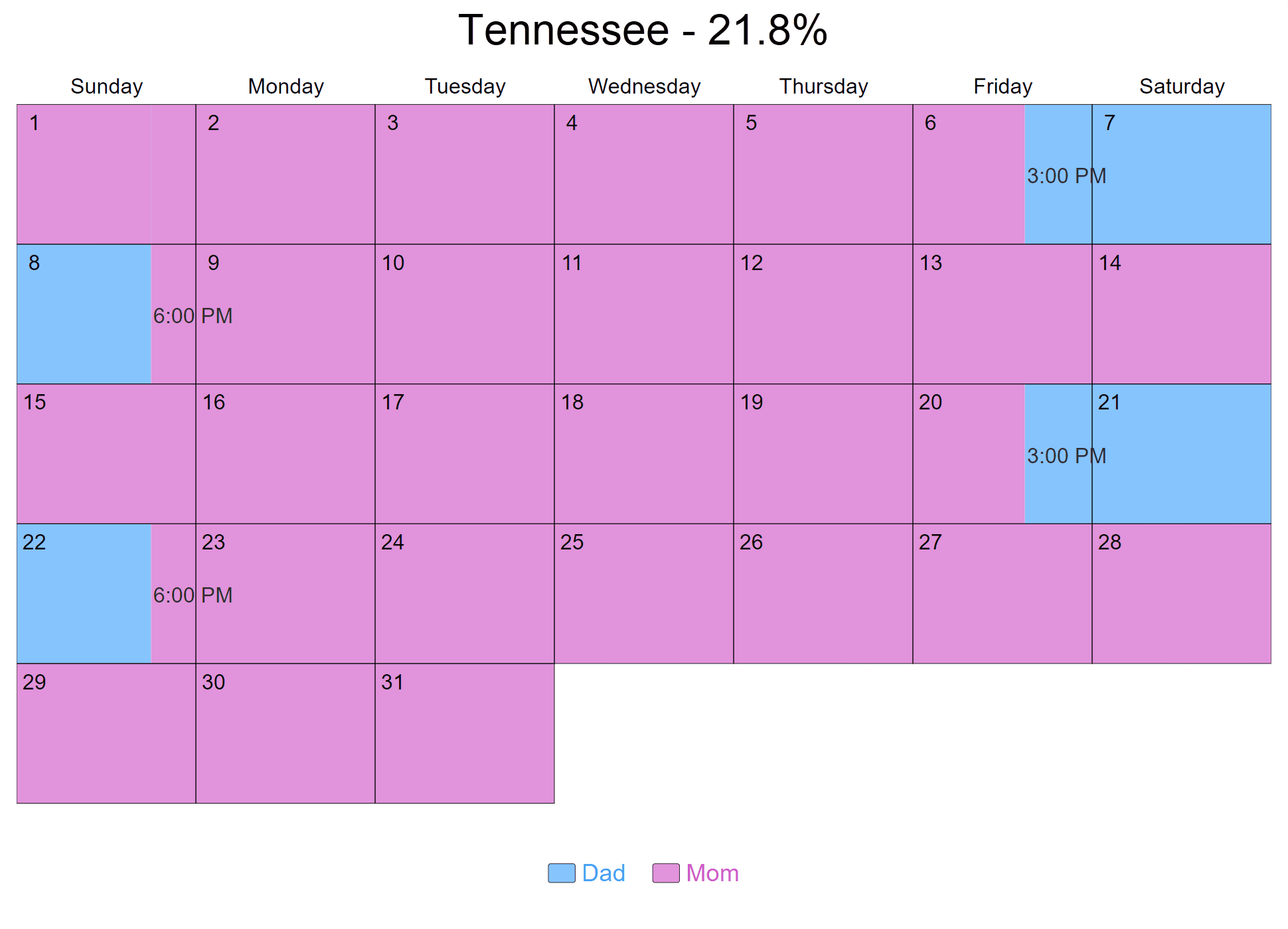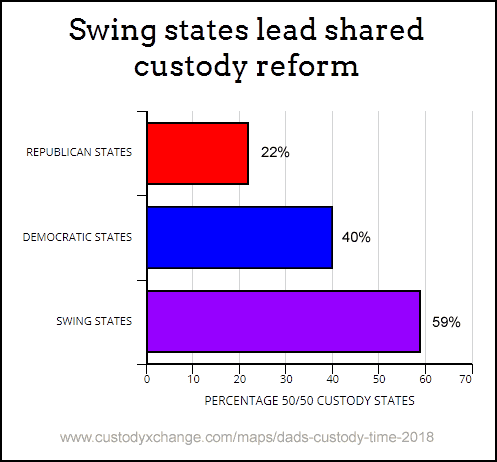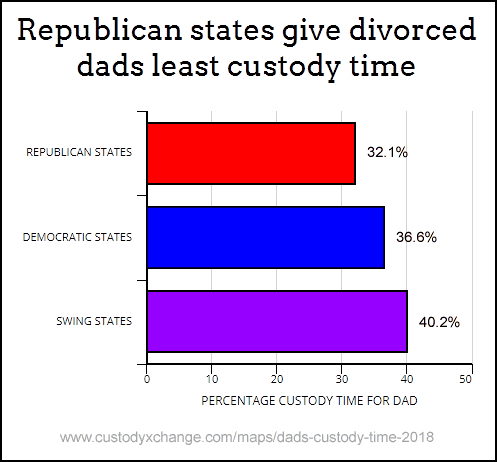How much custody time does Dad get in your state?
Study shows fathers' share of parenting time varies greatly by state
Custody X Change conducted a first-of-its-kind study and found that parenting time varies dramatically as you cross state lines. Nationwide, a father is likely to receive about 35% of child custody time. See how your state compares below.
If you're co-parenting, you may want to try Custody X Change. It helps you keep track of your schedule, calculate your parenting time and write a parenting plan. Make my schedule and plan now.

Download: PNG | JPG; Use image with attribution
Rare insight into national custody statistics
"Custody schedules are detailed and complex, which makes them hard to compare," said Ben Coltrin, Custody X Change co-founder and president. "However, it's easy to see the state-by-state differences once you have a percentage for every state. We conducted this study to be able to easily highlight these differences."
The percentages in the study reflect cases in which both parents want custody and no complicating circumstances exist ― such as criminal convictions or long-distance separation. It demonstrates the most commonly awarded visitation schedules given to a noncustodial parent by state.
Politics and parenting time
The study also shows red states have been the least eager to move toward equal custody time for both parents. Twenty-two percent of red states currently give equal custody as standard, compared to 40% of blue states and 59% of purple states.
On average, a typical divorced dad living in a red state will see his child 400 fewer hours each year than a blue-state dad and 700 fewer hours than a purple-state dad. Divorced dads in purple states receive an average of 40.2% of custody time as standard ― or about 3,500 hours. Blue-state dads receive about 3,200 hours (36.6%), while red-state dads only get about 2,800 hours in a typical parenting arrangement (32.1%).
Trending toward equal time with each parent
In recent years, many states have moved to give divorced fathers more time with their children. In 2017 alone, 25 state legislatures considered laws to encourage shared parenting after divorce or make it the default, as reported by The Washington Post.
"Our study shows 40% of states aim to give children equal time with each parent."
-Ben Coltrin, Custody X Change President
"Our study shows 40% of states aim to give children equal time with each parent," said Coltrin. "We're hoping this study will affect the dialog that's taking place as states consider changing their custody laws. States may increase time for dads, as they compare themselves to their neighbor-states."
What does a custody percentage really mean?
Florida's 50% parenting time equates to about 183 days per year for Dad. California's 32.8% of time equates to about 120 days per year for Dad. Tennessee's 21.8% of time equates to about 80 days per year. Fathers living in an equal custody state, such as Florida, are likely to see their children for 100 more days a year than fathers living in Tennessee, the state least generous to fathers.
See typical schedules for these three states below.
 You can customize this with Custody X Change.
You can customize this with Custody X Change. You can customize this with Custody X Change.
You can customize this with Custody X Change. You can customize this with Custody X Change.
You can customize this with Custody X Change.How we did the research
The research was conducted over four months in 2018 by talking to legal professionals in every state to learn the most commonly awarded schedule there. The research involved over one thousand emails and hundreds of phone calls. No customer data was used.
We then took the detailed custody schedules and entered them into the Custody X Change software to give us the parenting time percentages for each state. One reason state-by-state custody share percentages have not previously been published is that the only way to get an accurate percentage is by using software, and Custody X Change is one of the only software packages that can calculate these percentages.
State by state rankings
| Rank | State | Pct |
| # 1 | Alaska | 50% |
| # 1 | Arizona | 50% |
| # 1 | Colorado | 50% |
| # 1 | Connecticut | 50% |
| # 1 | Delaware | 50% |
| # 1 | Florida | 50% |
| # 1 | Kentucky | 50% |
| # 1 | Maine | 50% |
| # 1 | Massachusetts | 50% |
| # 1 | Minnesota | 50% |
| # 1 | Missouri | 50% |
| # 1 | Nevada | 50% |
| # 1 | New Hampshire | 50% |
| # 1 | New Jersey | 50% |
| # 1 | New Mexico | 50% |
| # 1 | North Dakota | 50% |
| # 1 | Vermont | 50% |
| # 1 | Virginia | 50% |
| # 1 | West Virginia | 50% |
| # 1 | Wisconsin | 50% |
| # 21 | Alabama | 33.7% |
| # 22 | Texas | 33% |
| # 23 | Nebraska | 32.9% |
| # 24 | California | 32.8% |
| # 25 | Hawaii | 31% |
| # 26 | New York | 30.4% |
| # 27 | Indiana | 28.8% |
| # 28 | Oregon | 28.7% |
| # 29 | Wyoming | 28.6% |
| # 30 | Iowa | 28.3% |
| # 31 | Pennsylvania | 28.8% |
| # 32 | Arkansas | 28.1% |
| # 33 | North Carolina | 27.9% |
| # 34 | South Carolina | 27.8% |
| # 35 | Michigan | 27.1% |
| # 36 | Kansas | 26.4% |
| # 37 | Utah | 26.2% |
| # 38 | Maryland | 26.1% |
| # 39 | Montana | 26% |
| # 40 | Louisiana | 25.4% |
| # 41 | Idaho | 24.1% |
| # 42 | Rhode Island | 24% |
| # 43 | Washington | 23.8% |
| # 44 | Ohio | 23.7% |
| # 45 | South Dakota | 23.6% |
| # 46 | Georgia | 23.5% |
| # 47 | Illinois | 23.1% |
| # 48 | Mississippi | 23% |
| # 49 | Oklahoma | 22.4% |
| # 50 | Tennessee | 21.8% |
Parenting schedules for all 50 states
Each state's most common schedule can be found on our appendix page, along with the sources we used.


